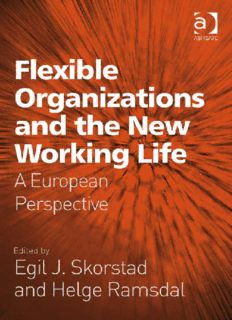
Flexible Organizations and the New Working Life PDF
Preview Flexible Organizations and the New Working Life
Flexible OrganizatiOns and the new wOrking liFe This page has been left blank intentionally Flexible Organizations and the new working life a european Perspective Edited by egil J. skOrstad Østfold University College, Norway helge ramsdal Østfold University College, Norway © egil J. skorstad and helge ramsdal 2009 all rights reserved. no part of this publication may be reproduced, stored in a retrieval system or transmitted in any form or by any means, electronic, mechanical, photocopying, recording or otherwise without the prior permission of the publisher. egil J. skorstad and helge ramsdal have asserted their rights under the Copyright, designs and Patents Act, 1988, to be identified as the editors of this work. Published by ashgate Publishing limited ashgate Publishing Company wey Court east suite 420 Union road 101 Cherry street Farnham burlington surrey, gU9 7Pt Vt 05401-4405 england Usa www.ashgate.com British Library Cataloguing in Publication Data Flexible organizations and the new working life : a european perspective 1. human capital 2. Organizational effectiveness 3. industrial relations i. skorstad, egil J. ii. ramsdal, helge 658.3 Library of Congress Cataloging-in-Publication Data skorstad, egil, 1945- Flexible organizations and the new working life : a european perspective / by egil J. skorstad and helge ramsdal. p. cm. includes index. isbn 978-0-7546-7420-7 -- isbn 978-0-7546-9151-8 (ebook) 1. hours of labor, Flexible--europe--Cross-cultural studies. 2. Organizational culture--europe--Cross-cultural studies. 3. Organizational behavior--europe--Cross-cultural studies. 4. Quality of work life--europe--Cross-cultural studies. i. ramsdal, helge. ii. title. hd5109.2.e85s56 2009 331.25'724094--dc22 09ANSHT 2008048575 isbn 978 0 7546 7420 7 eisbn 978 0 7546 9151 8 (ebook) Contents List of Figures vii List of Tables iv List of Contributors xi Preface xv 1 introduction 1 Helge Ramsdal and Egil J. Skorstad 2 the ambiguity of Flexibility 17 Egil J. Skorstad 3 the impact of Flexibility on employee morale and involvement: large-sample Findings for Uk workplaces 43 Michael Rose 4 whose Flexibility? british employees’ responses to Flexible Capitalism 79 Harriet Bradley 5 a Package of Flexibility? 97 Birgitta Eriksson and Jan Ch. Karlsson 6 Protected, Firm-Specific, and Scarce: Explanations of non-standard Forms of employment 111 R. Øystein Strøm 7 Combining Flexibility and workers’ motivation: lessons from a study on italian and French hospitals 143 Philippe R. Mossé 8 striving for Flexibility, attaining resistance: Culture Clashes in the swedish rail industry 163 Henrietta Huzell 9 the re-Organization of manufacturing and the emergence of a Flexible economy in the Uk 187 Stephen Ackroyd vi Flexible Organizations and the New Working Life 10 the Quest for Flexibility and governmental regulations of working life: the Case of the 2005 norwegian worker Protection and working environment act 209 Helge Ramsdal 11 what’s special about the nordic Countries? On Flexibility, globalization and working life 233 Tor Claussen 12 Concluding remarks: the Complex dynamism of the Flexible Organization 257 Egil J. Skorstad Index 265 list of Figures 3.1 Number of flexibility practices and level of morale 69 4.1 graduate destinations in 2003 93 6.1 the OeCd (1999) ranking of member states according to the establishments’ costs related to individual or collective dismissals 114 6.2 total labour force (left hand scale) in 1,000 persons and percentage of women and unemployment (right hand scale) in norway from 1972 to 2006 119 6.3 the average working year (left hand scale) and total hours worked (right hand scale) in manufacturing and health in norway from 1970 to 2004 121 6.4 normalized full-time employment in major norwegian industries from 1970 to 2004 122 6.5 total and part-time employment for men and women in manufacturing and the health services in norway from 1996 to 2007 127 6.6 temporary work among men and women – 1,000 persons, from 1996 to 2007 131 6.7 the percentage of workers engaged in temporary employment in manufacturing, retail, hotels and restaurants (‘rethot’), education and health services in norway from 1996 to 2007 132 6.8 the percentage of all and non-agricultural self-employed workers in norway from 1970 to 2004 133 8.1 the management perspective and the resistance perspective in relation to change within the domains of legitimacy, restructuring and revaluating 172 This page has been left blank intentionally list of tables 3.1 Numerical flexibility: Employers’ use of non-standard contracts, 1998 and 2004 48 3.2 Numerical flexibility, organizational commitment, perceived workplace relations 50 3.3 Numerical flexibility: Employers’ use of outsourcing, 1998 and 2004 52 3.4 Outsourcing, workplace climate and organizational attachment 53 3.5 Numerical flexibility: Jobs in workplace not guaranteed/exempt from compulsory redundancy and approval of management, perceived workplace relations and organizational commitment 54 3.6 Temporal flexibility: Overtime working, 1998 and 2004 57 3.7 Temporal flexibility: Overtime working, workplace climate and organizational attachment 58 3.8 Temporal flexibility, effect of having a 24/7 work schedule 59 3.9 stretched contract working, manager informant agreed/ strongly agreed 61 3.10 Functional flexibility – Teamwork (definitions for 1998 and 2004, restricted 2004) 63 3.11 training for job-switching, workplace climate and organizational attachment 65 3.12 mean level (0–6) of largest OUg ‘formally trained’ do other job (fxfunc_trainedojb) 66 3.13 actual job switching, workplace climate and organizational attachment (wers 5 only) 67 3.14 Scope of flexibility practice in UK workplaces with five or more employees 68 4.1 Changing proportions of firms reporting usage of different types of flexible working 83 4.2 Percentage of firms in survey reporting availability of different types of non-standard contractual arrangements 84 4.3 income levels by age group 92 5.1 Workplaces that have different types of flexibility (percentages) 99 5.2 types of work environments according to karasek’s model 103 5.3 different types of working conditions at the workplace with various types of flexibility and various aspects of new management (percentages) 104 5.4 Employees in different types of work environments at flexible and non-flexible workplaces (vertical percentages) 105
Description: